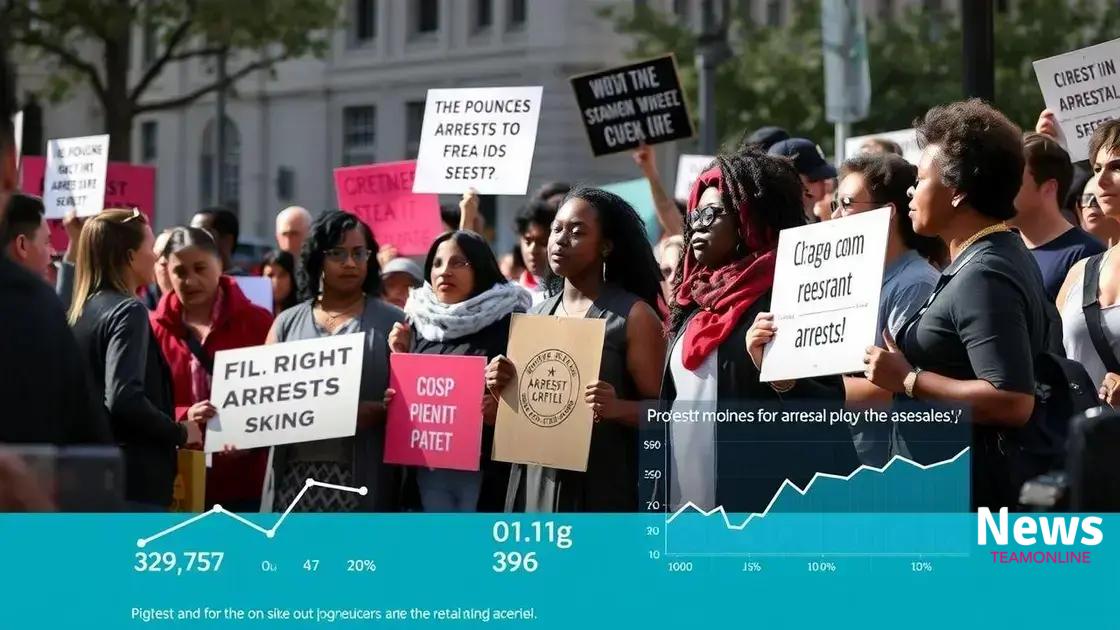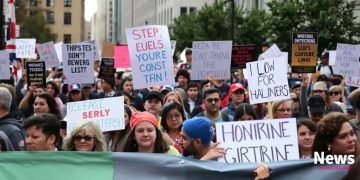National registry for protest-related arrests: what you need to know

The national registry for protest-related arrests provides critical data on law enforcement practices, enhancing transparency and accountability while supporting civil rights advocacy through detailed documentation of arrests during demonstrations.
The national registry for protest-related arrests is a crucial tool for tracking civil rights violations. Have you ever wondered how it affects accountability and justice in our society? Let’s dive into its significance.
Understanding the national registry for protest-related arrests
Understanding the national registry for protest-related arrests is essential for recognizing how it functions in our society today. This registry serves as a key resource for monitoring and documenting arrests made during protests. Knowing its significance can help you grasp the broader implications for civil rights and accountability.
What is the national registry?
The national registry is an official collection of data regarding individuals who have been arrested during protests across the country. This system aims to create transparency in law enforcement practices during demonstrations. By tracking these incidents, the registry allows for greater oversight and public awareness of arrest patterns.
Why is the registry important?
The importance of this registry cannot be overstated. Here are a few reasons why it matters:
- Accountability: It holds law enforcement accountable for their actions during protests.
- Data-driven decisions: It provides necessary data for policymakers to make informed decisions about protest management.
- Public awareness: The registry informs the public about trends in protest-related arrests.
This data helps advocates and organizations to address issues related to civil rights. By shining a light on these arrests, the registry highlights potential injustices, prompting discussions about law enforcement practices.
In addition to accountability, the registry also serves as a resource for legal aid organizations. These groups can utilize the information provided by the registry to assist individuals who might face charges stemming from protests. They can identify trends in arrests, which can help to strategize legal defenses and ensure that individuals receive fair representation.
The legal framework surrounding protest-related arrests
The legal framework surrounding protest-related arrests is essential for understanding the rights of individuals participating in demonstrations. Laws vary from state to state, making it crucial for protesters to be aware of their legal protections and potential risks.
Key legal principles
Several legal principles govern how law enforcement can interact with protesters. First, the First Amendment of the U.S. Constitution protects the right to assembly and free speech. This means individuals have the right to protest peacefully without fear of arrest.
Common laws affecting protests
In addition to constitutional rights, various laws play significant roles during protests. Here are some common legal considerations:
- Public order laws: These laws ensure that protests do not disrupt public safety or order.
- Permitting requirements: Some jurisdictions require protesters to obtain permits for organized gatherings.
- Police conduct: Law enforcement must adhere to rules regarding reasonable force and engagement with protesters.
These legal principles help shape how protests are managed. Unfortunately, misunderstandings can lead to unlawful arrests. This situation highlights the importance of knowing your rights before participating in a demonstration.
Legal counsel is critical for those arrested during protests. Lawyers can assist in navigating the complexities of law related to these incidents. They can help define the context of an arrest and ensure that rights are protected during legal proceedings.
Understanding the legal landscape can empower individuals to participate in protests confidently. When people know their rights, they can better advocate for fair treatment and accountability among law enforcement officials.
How the registry impacts civil rights

The registry plays a crucial role in shaping and influencing civil rights in our society. By documenting protest-related arrests, it provides a clear picture of law enforcement practices during demonstrations.
Transparency and accountability
One significant way the registry impacts civil rights is through increased transparency. When arrest data is available to the public, it allows citizens to hold law enforcement accountable. Increased accountability discourages unlawful or biased arrests during protests. This can help protect the rights of individuals exercising their freedom of speech.
Evidence for advocacy
Furthermore, the registry serves as an important tool for civil rights advocates. Here are a few ways it aids their efforts:
- Identifying patterns: Advocates can analyze the data to discover trends in arrests, such as which communities are affected most.
- Raising awareness: The information can be shared with the public to highlight injustices faced by protesters.
- Legal support: It can help organizations prepare cases for individuals detained during protests.
This ability to gather and analyze data can strengthen movements for social justice. With a thorough understanding of how protest-related arrests occur, advocates can inform policy changes that enhance protections for individuals protesting peacefully.
The registry also helps to demonstrate the real-life impacts of arrests. When people see the numbers and hear the stories behind them, it becomes clear how crucial it is to protect civil liberties during protests. Overall, the existence of a national registry encourages conversations about civil rights and fosters a culture that prioritizes the protection of those rights.
Case studies of protest-related arrests
Case studies of protest-related arrests provide important insights into how law enforcement operates during demonstrations. These examples illustrate the challenges and outcomes faced by individuals during protests.
Example 1: The Women’s March
In January 2017, the Women’s March took place across the United States, with millions participating to advocate for women’s rights. While the majority of protesters remained peaceful, some individuals were arrested for minor infractions. This situation sparked discussions on the balance between protest rights and public safety. The use of arrest data from this event has helped advocates push for more accountable law enforcement practices.
Example 2: Black Lives Matter Protests
During the Black Lives Matter protests in 2020, many participants were arrested across various cities. These case studies revealed significant discrepancies in how law enforcement treated different groups of protesters. Reports showed that some arrests were based on arbitrary enforcement of laws, raising concerns about racial profiling and civil rights violations.
- Statistical analysis: Data collected from these protests have been analyzed to identify patterns of arrests by geography and demographics.
- Legal challenges: Numerous legal challenges were filed against law enforcement agencies due to unlawful arrests, highlighting the registry’s role in advocacy.
- Public reactions: These case studies fueled public outcry and further mobilized community responses.
These examples emphasize the importance of the national registry for tracking protest-related arrests. It helps provide a clear picture of the events surrounding large-scale protests. Moreover, they showcase how data can empower movements that fight for justice and accountability.
Understanding individual stories behind arrests gives depth to the statistical data. By examining these case studies, we grasp how protests not only impact laws but also shape societal perceptions of justice and rights.
Future developments in the national registry
Future developments in the national registry for protest-related arrests could significantly impact how arrests are handled and monitored. As society continues to evolve, so do the methods for gathering and analyzing data pertaining to protests.
Enhanced data collection methods
One area of growth is improving data collection methods. New technologies, such as mobile apps and online platforms, may allow for more efficient reporting of arrests during protests. This change could lead to real-time updates that provide better insights into ongoing events.
Increased transparency initiatives
Transparency initiatives play a vital role in shaping future developments. Encouraging the creation of public databases could help citizens access information easily. This access creates community trust and enhances accountability among law enforcement, ensuring that the data reflects the actual experiences of protesters.
- Standardized reporting: Efforts will be made to standardize how police reports are filed, making it easier to compare data across regions.
- Public engagement: Engaging citizens in discussions about data use will encourage community involvement and address any disparities in enforcement.
- Policy adaptation: As new data emerges, policymakers will need to adapt existing laws and policies to better protect civil rights during protests.
Another promising area of focus is the use of artificial intelligence to analyze patterns in protest-related arrests. AI can help identify trends and make predictions about potential issues, enhancing preparedness for future protests.
As each development occurs in the national registry, civil rights organizations will likely use this information to bolster their advocacy efforts. They can advocate for reforms based on what the data shows, aiming to create fairer and more just outcomes for peaceful protesters.
FAQ – Frequently Asked Questions about the National Registry for Protest-Related Arrests
What is the purpose of the national registry for protest-related arrests?
The registry aims to increase transparency and accountability in law enforcement during protests by documenting arrest incidents.
How does the registry impact civil rights?
By providing data on arrests, the registry helps advocate for civil rights, holding law enforcement accountable and empowering movements for justice.
What types of information does the registry collect?
The registry collects data on arrest locations, reasons for arrests, demographics of those arrested, and patterns of law enforcement behavior.
How can the public access the information in the registry?
Future developments aim to make the registry more accessible through public databases and online platforms, allowing citizens to view arrest data.





